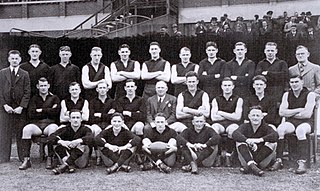
The Charles Brownlow Trophy, better known as the Brownlow Medal, is awarded to the Best and fairest player in the Australian Football League (AFL) during the home-and-away season, as determined by votes cast by the four officiating field umpires after each game. It is the most prestigious award for individual players in the AFL. It is also widely acknowledged as the highest individual honour in the sport of Australian rules football.

Wilfred Arthur "Chicken" Smallhorn was an Australian rules footballer who played for the Fitzroy Football Club in the Victorian Football League (VFL). Smallhorn played 150 games for Fitzroy between 1930 and 1940, winning the Brownlow Medal in 1933.

The 1915 VFL season was the 19th season of the Victorian Football League (VFL), the highest-level senior Australian rules football competition in Victoria. The season featured nine clubs and ran from 24 April to 18 September, comprising a 16-match home-and-away season followed by a four-week finals series featuring the top four clubs.
The 1984 VFL season was the 88th season of the Victorian Football League (VFL), the highest level senior Australian rules football competition in Victoria. The season featured twelve clubs, ran from 31 March until 29 September, and comprised a 22-game home-and-away season followed by a finals series featuring the top five clubs.
The 1983 VFL season was the 87th season of the Victorian Football League (VFL), the highest-level senior Australian rules football competition in Victoria.
The 1959 VFL season was the 63rd season of the Victorian Football League (VFL), the highest level senior Australian rules football competition in Victoria. The season featured twelve clubs, ran from 18 April until 26 September, and comprised an 18-game home-and-away season followed by a finals series featuring the top four clubs.
The 1960 VFL season was the 64th season of the Victorian Football League (VFL), the highest level senior Australian rules football competition in Victoria. The season featured twelve clubs, ran from 16 April until 24 September, and comprised an 18-game home-and-away season followed by a finals series featuring the top four clubs.
The 1962 VFL season was the 66th season of the Victorian Football League (VFL), the highest level senior Australian rules football competition in Victoria. The season featured twelve clubs, ran from 21 April until 29 September, and comprised an 18-game home-and-away season followed by a finals series featuring the top four clubs.
The 1964 VFL season was the 68th season of the Victorian Football League (VFL), the highest level senior Australian rules football competition in Victoria. The season featured twelve clubs, ran from 18 April until 19 September, and comprised an 18-game home-and-away season followed by a finals series featuring the top four clubs.
The 1933 VFL season was the 37th season of the Victorian Football League (VFL), the highest-level senior Australian rules football competition in Victoria. The season featured twelve clubs and ran from 29 April to 30 September, comprising an 18-match home-and-away season followed by a four-week finals series featuring the top four clubs.

The 1937 VFL season was the 41st season of the Victorian Football League (VFL), the highest level senior Australian rules football competition in Victoria. The season featured twelve clubs, ran from 24 April until 25 September, and comprised an 18-game home-and-away season followed by a finals series featuring the top four clubs.

The 1940 VFL season was the 44th season of the Victorian Football League (VFL), the highest level senior Australian rules football competition in Victoria. The season featured twelve clubs, ran from 27 April until 28 September, and comprised an 18-game home-and-away season followed by a finals series featuring the top four clubs.

The 1942 VFL season was the 46th season of the Victorian Football League (VFL), the highest level senior Australian rules football competition in Victoria.

The 1943 VFL season was the 47th season of the Victorian Football League (VFL), the highest level senior Australian rules football competition in Victoria.

The 1946 VFL season was the 50th season of the Victorian Football League (VFL), the highest level senior Australian rules football competition in Victoria.
The 1947 VFL season was the 51st season of the Victorian Football League (VFL), the highest level senior Australian rules football competition in Victoria. The season featured twelve clubs, ran from 19 April until 27 September, and comprised a 19-game home-and-away season followed by a finals series featuring the top four clubs.

Robert Mainwaring Chitty was an Australian rules footballer in the Victorian Football League (VFL).

The Anzac Day match is an annual Australian rules football match between Collingwood and Essendon, two clubs in the Australian Football League, held on Anzac Day at the Melbourne Cricket Ground (MCG).

Leslie Allan "Peter" Chitty BEM was an Australian rules footballer who played for St Kilda in the Victorian Football League (VFL). He was a prisoner of war held at Changi prison during the Second World War. Chitty won the only "Changi Brownlow" medal to be awarded as part of the Changi Australian rules football competition. In 2024, it was reported in the Corryong Courier that an Australian red ensign bearing the words "Changi '41 '42" and "Chitty flag" had been discovered, which may have flown over the game where Chitty was awarded the Changi Brownlow.
The AFL Australian Football League is the top professional Australian rules football league in the world. The league consists of eighteen teams: nine based in the city of Melbourne, one from regional Victoria, and eight based in other Australian states. The reason for this unbalanced geographic distribution lies in the history of the league, which was based solely within Victoria from the time it was established in 1897, until the time the league expanded through the addition of clubs from interstate to the existing teams starting in the 1980s; until this expansion, the league was known as the VFL (Victorian Football League).















